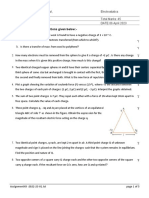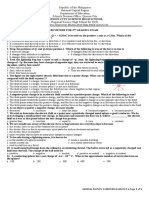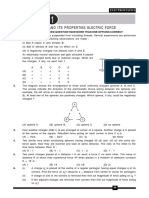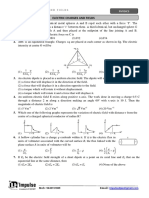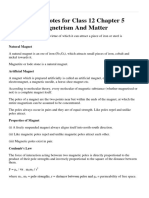Assignment 1
Uploaded by
RVNGR I HUNTERAssignment 1
Uploaded by
RVNGR I HUNTERAssignment 1
1. In given figure, two positive charges q2 and q3 fixed along the y axis, exert a net electric force in
the + x direction on a charge q1 fixed along the x axis. If a positive charge Q is added at (x, 0), the
force on q1
(a) shall increase along the positive x-axis
(b) shall decrease along the positive x-axis
(c) shall point along the negative x-axis
(d) shall increase but the direction changes because of the intersection of Q with q2 and q3
2. Two charges q and –3q are placed fixed on x-axis separated by distance ‘d’. Where should a third charge 2q be
placed such that it will not experience any force?
3. Three charges q1 = 1 µC, q2 = – 2 µC and q3 = 3 µC are placed on the vertices of an equilateral triangle of side
1.0 m. Find the net electric force acting on charge q1 .
4. Two positive point charges q1 = 16 µC and q2 = 4 µC, are separated in vacuum by a distance of 3.0 m. Find the
point on the line between the charges where the net electric field is zero.
5. Select the correct answer to these questions from the codes (a), (b), (c) and (d) as given below.
a) Both A and R are true and R is the correct explanation of A
b) Both A and R are true but R is NOT the correct explanation of A
c) A is true but R is false
d) A is false and R is also false
(i) Assertion (A): The electrostatics force increases with decrease the distance between the charges.
Reason (R): The electrostatic force of attraction or repulsion between any two stationary point charges is inversely
proportional to the square of the distance between them.
(ii) Assertion (A): The Coulomb force between two points charges depend upon the dielectric constant of the
intervening medium.
Reason (R): Coulomb’s force varies inversely with the dielectric constant of medium.
(iii) Assertion (A): The charge given to a metallic sphere does not depend on whether it is hollow or solid
Reason (R): The charge resides only at the surface of conductor.
(iv) Assertion (A): A comb run through one’s dry hair attracts small bits of paper.
Reason(R): Molecules in the paper gets polarized by the charged comb resulting in net force of attraction
(v) Assertion(A): The total amount of charge on a body equal to 4 x 10-19 C is not possible.
Reason(R): Experimentally it is established that all free charges are integral multiples of a basic unit of charge
denoted by e. Thus, charge q on a body is always given by q = ne.
(vi) Assertion(A): Electric field at the surface of a charged conductor is always normal to the surface at every
point.
Reason(R): Electric field gives the magnitude & direction of electric force (F) experienced by any charge placed
at any point.
You might also like
- PHY71-Practice Questions-T1 (Part 1) - Teachers-AY2020-2021100% (1)PHY71-Practice Questions-T1 (Part 1) - Teachers-AY2020-202129 pages
- Class 12 Vedantu Physics CHP 1 Objective Questions With SolutionsNo ratings yetClass 12 Vedantu Physics CHP 1 Objective Questions With Solutions28 pages
- Electric Charges and Fields- Worksheet 1No ratings yetElectric Charges and Fields- Worksheet 15 pages
- Assignment - 1 (Electric Charge and Coulomb's Law)No ratings yetAssignment - 1 (Electric Charge and Coulomb's Law)5 pages
- Assignment_Electrostatics_Enthuse1-Allen-1No ratings yetAssignment_Electrostatics_Enthuse1-Allen-14 pages
- Ch. 1 Electric Charges and Fields Revision SheetNo ratings yetCh. 1 Electric Charges and Fields Revision Sheet10 pages
- 1 .2013 El Force and El Field Hw-PracticeNo ratings yet1 .2013 El Force and El Field Hw-Practice12 pages
- Electric Charges And Fields _ Practice Sheet __ 12th Hacker - CBSE 2025No ratings yetElectric Charges And Fields _ Practice Sheet __ 12th Hacker - CBSE 20256 pages
- Electric Charges and Fields Sub. Test 30th April 2023No ratings yetElectric Charges and Fields Sub. Test 30th April 20234 pages
- 6757cb188c36923ea6f1d3ac_##_Electric charges and Fields Assignment 02 (1)No ratings yet6757cb188c36923ea6f1d3ac_##_Electric charges and Fields Assignment 02 (1)12 pages
- Xi-Jee - A Batch Test - 23 - (10.03.2024) Paper& Answer Key PDFNo ratings yetXi-Jee - A Batch Test - 23 - (10.03.2024) Paper& Answer Key PDF13 pages
- Assignment 1 Electrostatics (Charge, Electric Field)No ratings yetAssignment 1 Electrostatics (Charge, Electric Field)2 pages
- CLS Aipmt 18 19 XII Phy Study Package 5 SET 2 Chapter 183% (12)CLS Aipmt 18 19 XII Phy Study Package 5 SET 2 Chapter 136 pages
- Electrostatis - DPP - 02 - Aditya Sir - Electrostatis - DPP - 02 - Aditya Sir - Electrostatis - DPP - 02 - Aditya SirNo ratings yetElectrostatis - DPP - 02 - Aditya Sir - Electrostatis - DPP - 02 - Aditya Sir - Electrostatis - DPP - 02 - Aditya Sir2 pages
- Scoremore Case Study Chaperwise Practice Questions Physics Class 12 Sample ShortNo ratings yetScoremore Case Study Chaperwise Practice Questions Physics Class 12 Sample Short9 pages
- Essential Sheet Electrostatics Exercise-1 To 2No ratings yetEssential Sheet Electrostatics Exercise-1 To 224 pages
- Physics Home Assignment Electrostatics: Stay Home! Stay Safe!100% (1)Physics Home Assignment Electrostatics: Stay Home! Stay Safe!20 pages
- Electron Beam-Specimen Interactions and Simulation Methods in MicroscopyFrom EverandElectron Beam-Specimen Interactions and Simulation Methods in MicroscopyNo ratings yet
- Problems in Quantum Mechanics: Third EditionFrom EverandProblems in Quantum Mechanics: Third EditionD. ter Haar3/5 (2)
- CRC Handbook of Fundamental Spectroscopic Correlation ChartsNo ratings yetCRC Handbook of Fundamental Spectroscopic Correlation Charts20 pages
- Non-Ferrous Extractive Metallurgy Prof. H. S. RayNo ratings yetNon-Ferrous Extractive Metallurgy Prof. H. S. Ray22 pages
- Gfps 700278068 Manual Type 335 350 Variable Area Flow Meter enNo ratings yetGfps 700278068 Manual Type 335 350 Variable Area Flow Meter en1 page
- A Lid-Driven Cavity Flow: December 19, 2006No ratings yetA Lid-Driven Cavity Flow: December 19, 200664 pages
- Design of Triple Effect Evaporator Developed by A Program in CNo ratings yetDesign of Triple Effect Evaporator Developed by A Program in C5 pages
- Purification, Characterization and Immobilization of A Keratinase From Aspergillus OryzaeNo ratings yetPurification, Characterization and Immobilization of A Keratinase From Aspergillus Oryzae9 pages
- Modeling and Characterization of Supercapaci Tor in Many Power Electronics ApplicationNo ratings yetModeling and Characterization of Supercapaci Tor in Many Power Electronics Application5 pages
- Exploration of Truss Metamaterials With GraphNo ratings yetExploration of Truss Metamaterials With Graph3 pages







